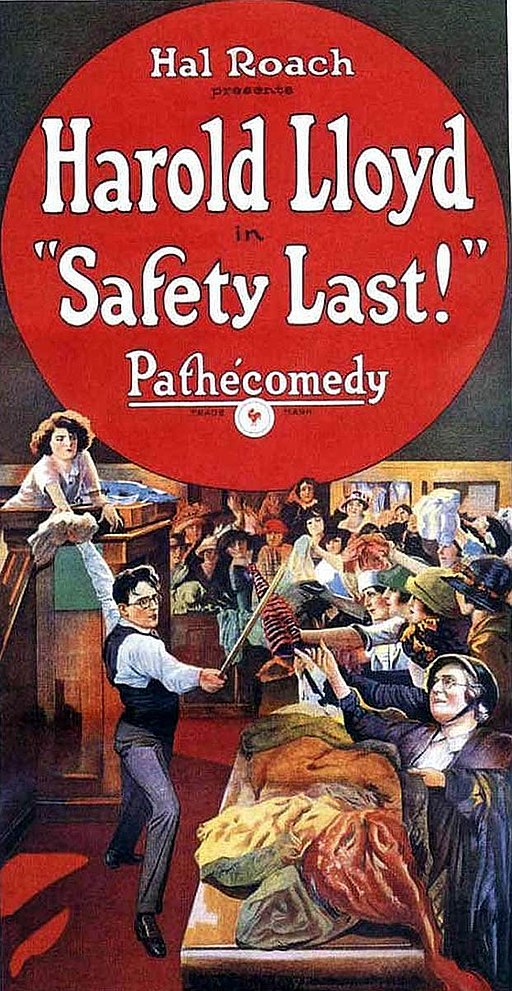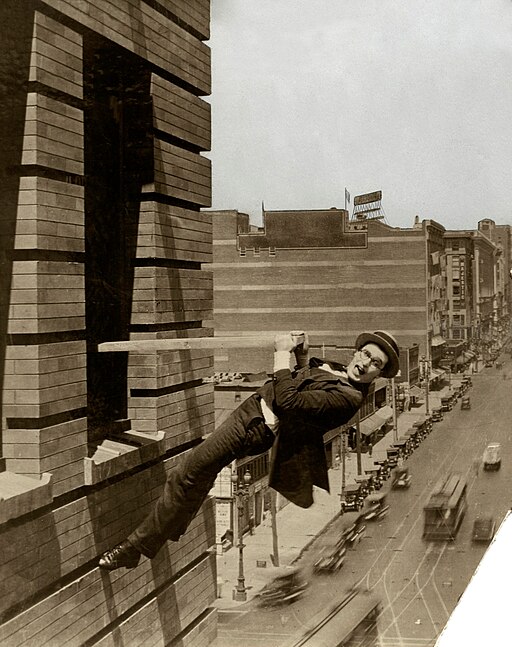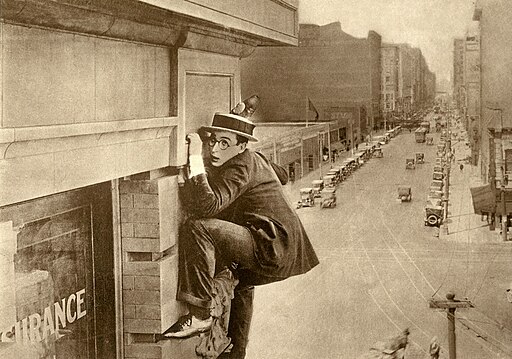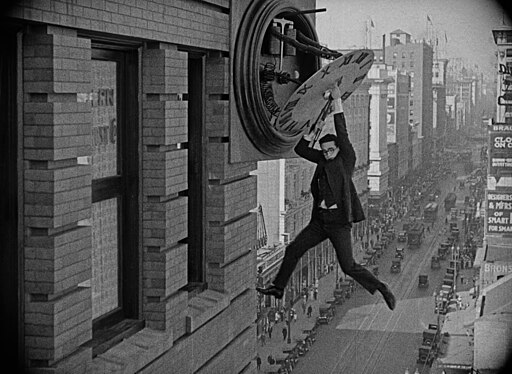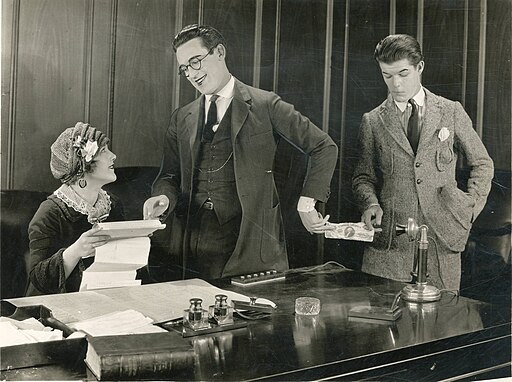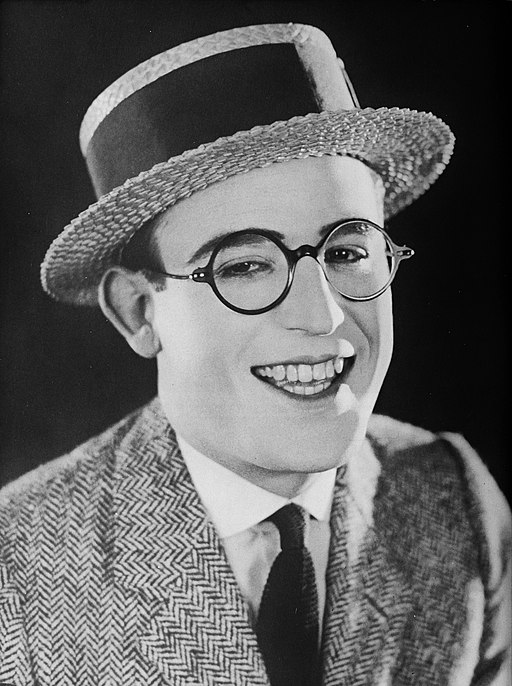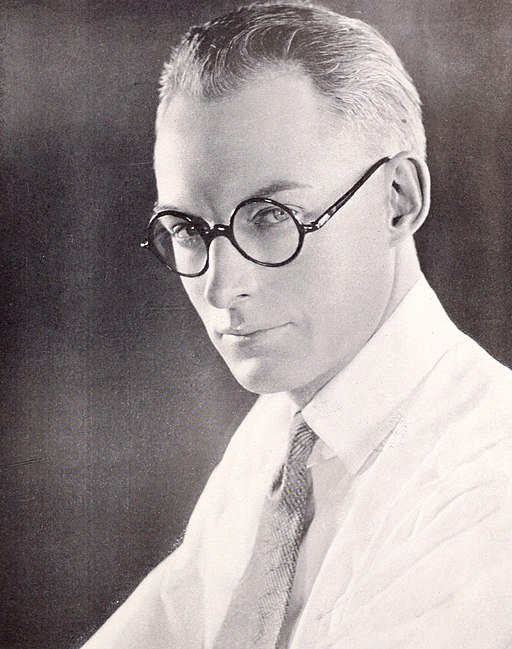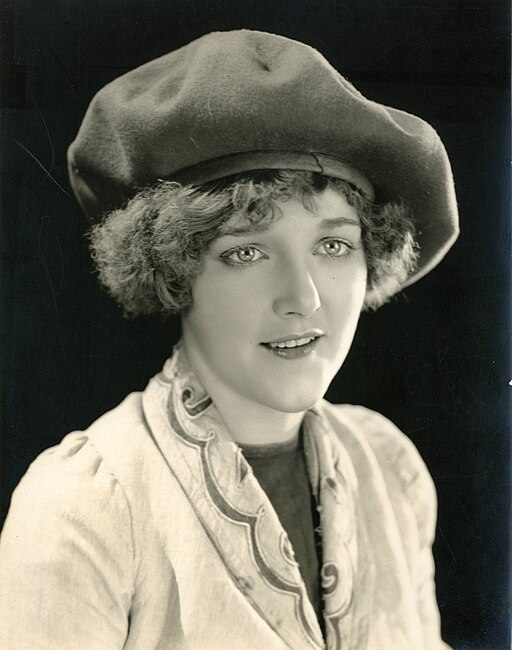Safety Last! - 1923
back| Released by | Pathé Exchange |
| Director | Fred C. Newmeyer and Sam Taylor |
| Producer | Hal Roach |
| Script | Hal Roach, Sam Taylor, Tim Whelan, and H.M. Walker |
| Cinematography | Walter Lundin and Hans F. Koenekamp |
| Music by | Silent movie |
| Running time | Approximately 70 minutes |
| Film budget | $121,963 |
| Box office sales | $2.6 million |
| Main cast | Harold lloyd - Mildred Davis - Bill Strother - Noah Young - Westcott Clarke |
Safety Last!
Masterpiece of Silent Comedy
"Safety Last" is a classic silent comedy that follows the misadventures of a small-town young man, The Boy, as he attempts to impress his sweetheart by performing a publicity stunt involving a daring climb up a tall department store building.
Directed by Fred C. Newmeyer and Sam Taylor, and starring Harold Lloyd in a career-defining role, the film is renowned for its breathtaking stunts, innovative visual storytelling, and timeless humor.
Related
Safety Last! – 1923
Summary and Analysis
"Safety Last!" is a classic silent comedy film that epitomizes the daredevil antics of its star, Harold Lloyd. Set in bustling 1920s America, the film follows the misadventures of a small-town young man, often referred to as "The Boy" (Harold Lloyd), as he navigates the challenges of urban life in pursuit of success and love.
The plot revolves around The Boy's desire to impress his sweetheart, The Girl (Mildred Davis), and send her a diamond ring to prove his affection. To achieve this, he promises her that he's working in a prestigious job in the city, though in reality, he's just a lowly store clerk. The central sequence of the film unfolds when The Boy's friend, The Pal (Bill Strother), convinces him to scale the exterior of a towering department store building as a publicity stunt. The Boy, known for his acrobatic prowess, reluctantly agrees, seeing it as an opportunity to earn the money he desperately needs.
What ensues is a breathtaking display of physical comedy and suspense as The Boy embarks on his perilous climb up the building's facade. His journey becomes increasingly fraught with obstacles and near-misses, including encounters with pesky pigeons, precarious ledges, and a memorable encounter with a clock, culminating in one of cinema's most iconic moments as he dangles precariously from the hands of the clock high above the city streets.
Behind the laughter and excitement, "Safety Last" offers a deeper commentary on the pursuit of the American Dream and the lengths individuals will go to achieve success and provide for their loved ones. The Boy's willingness to risk life and limb for the sake of love reflects the optimism and determination characteristic of the Roaring Twenties, a time of economic prosperity and cultural change.
Furthermore, the film's portrayal of urban life underscores the challenges and contradictions of modernity, juxtaposing the allure of the city with its inherent dangers and pitfalls. Through The Boy's escapades, the film explores themes of ambition, deception, and the resilience of the human spirit, all while delivering a steady stream of laughter and heart-pounding thrills.
In terms of its technical achievements, "Safety Last" showcases the innovative filmmaking techniques of its era, including groundbreaking use of perspective and forced perspective shots to create the illusion of height and vertigo-inducing stunts. Harold Lloyd's meticulous attention to detail and dedication to his craft shine through in every frame, earning him a place among the silent era's most beloved and influential comedians.
Overall, "Safety Last" remains a timeless masterpiece of silent cinema, cherished for its humor, ingenuity, and timeless appeal. As a testament to the enduring power of physical comedy and the human spirit, it continues to entertain and inspire audiences nearly a century after its initial release.
Classic Scene from Safety Last!:
Full Cast:
- Harold Lloyd as The Boy
- Mildred Davis as The Girl
- Bill Strother as The Pal
- Noah Young as The Law
- Westcott Clarke as The Floorwalker
- Earl Mohan as The Drunk
- Charles Stevenson as The Manager
- Mickey Daniels as Extra (uncredited)
- Anna Dodge as The Landlady (uncredited)
- Helen Gilmore as The Law's Wife (uncredited)
- William Gillespie as Floorwalker (uncredited)
- Wallace Howe as Desk Clerk (uncredited)
- Gus Leonard as Spectator at Traffic Accident (uncredited)
- Charles Stevenson as Department Store Manager (uncredited)
- Eddie Sturgis as Floorwalker (uncredited)
- Sammy Brooks as Bit Part (uncredited)
- Gaylord Lloyd as Extra (uncredited)
- M.J. McCarthy as Policeman (uncredited)
- Mark Jones as Office Worker (uncredited)
- Daisy Earles as Maid (uncredited)
Co-Direction of Sam Taylor and Fred C. Newmeyer:
Fred C. Newmeyer and Sam Taylor co-directed "Safety Last," contributing to the film's iconic status in cinematic history. Their direction played a pivotal role in shaping the film's comedic timing, visual storytelling, and overall impact on audiences.
- Visual Comedy Mastery: Newmeyer and Taylor demonstrated a keen understanding of visual comedy, utilizing slapstick humor and sight gags to maximum effect. Their direction emphasized precise timing and choreography, enhancing the comedic elements of Harold Lloyd's performance. From elaborate stunt sequences to subtle facial expressions, every aspect of the film was meticulously crafted to elicit laughter from viewers.
- Innovative Cinematography: The directors employed innovative cinematography techniques to heighten the film's tension and excitement. The use of dynamic camera angles, forced perspective shots, and daring stunts created a sense of vertigo and suspense, immersing audiences in The Boy's perilous journey up the department store building. Newmeyer and Taylor's inventive approach to visual storytelling set "Safety Last" apart as a groundbreaking achievement in silent cinema.
- Narrative Pacing: The pacing of "Safety Last" is expertly handled by Newmeyer and Taylor, balancing moments of humor with moments of genuine suspense and emotion. They effectively structured the film to build tension gradually, leading to a climactic finale that keeps viewers on the edge of their seats. Through their direction, they ensured that each scene serves a purpose in advancing the narrative while maintaining audience engagement from start to finish.
- Character Development: Despite the film's focus on physical comedy, Newmeyer and Taylor also infused "Safety Last" with moments of character development and emotional resonance. Through subtle gestures and interactions, they fleshed out the personalities of the central characters, allowing audiences to empathize with their struggles and aspirations. The directors' attention to detail in portraying The Boy's motivations and relationships adds depth to the story, elevating it beyond mere spectacle.
- Legacy and Influence: The enduring popularity of "Safety Last" can be attributed in part to Newmeyer and Taylor's masterful direction. Their innovative techniques and comedic sensibilities have influenced generations of filmmakers, shaping the evolution of comedy in cinema. By pushing the boundaries of what was possible on screen, they left an indelible mark on the art form, cementing their status as pioneers of silent film direction.
In summary, Fred C. Newmeyer and Sam Taylor's direction in "Safety Last" is characterized by its visual ingenuity, narrative craftsmanship, and timeless appeal. Their collaborative efforts resulted in a cinematic masterpiece that continues to captivate audiences nearly a century after its release, solidifying their legacy as visionary filmmakers of the silent era.
Brilliant Performance of Harold Lloyd:
Harold Lloyd's performance in "Safety Last" is nothing short of extraordinary, showcasing his unparalleled talent as a physical comedian and actor. Through his portrayal of The Boy, Lloyd captivates audiences with his impeccable timing, boundless energy, and charismatic presence, earning him a place among the greatest silent film stars of all time.
- Physical Comedy Prowess: Lloyd's performance is characterized by his remarkable agility and athleticism, which he employs to execute a series of death-defying stunts and slapstick antics throughout the film. From precarious climbs up the side of a skyscraper to frenetic chases through city streets, Lloyd's mastery of physical comedy is on full display, eliciting laughter and applause from audiences with each daring maneuver.
- Expressive Facial Gestures: Despite the absence of spoken dialogue, Lloyd's facial expressions speak volumes, conveying a wide range of emotions from joy and determination to fear and desperation. His ability to convey complex emotions through subtle gestures and expressions adds depth to his character and enhances the comedic impact of the film.
- Charismatic Persona: As The Boy, Lloyd exudes charm and charisma, endearing himself to viewers with his boyish charm and optimistic outlook on life. Despite the character's misadventures and mishaps, Lloyd imbues The Boy with a sense of resilience and tenacity that makes him a relatable and lovable protagonist.
- Emotional Range: Beyond his comedic talents, Lloyd demonstrates considerable emotional range in "Safety Last," particularly in scenes depicting The Boy's romantic relationship with The Girl. His tender interactions with Mildred Davis's character reveal a softer, more vulnerable side to his persona, adding depth and nuance to his performance.
- Iconic Moments: Lloyd's performance in "Safety Last" is punctuated by several iconic moments that have become indelibly etched in cinematic history. From his precarious dangle from the hands of a clock high above the city streets to his triumphant ascent to the summit of the department store building, Lloyd delivers unforgettable moments that have stood the test of time.
Memorable Scenes from Safety Last!:
- The Building Climb: The climactic sequence of the film features Harold Lloyd's character, The Boy, attempting to climb the exterior of a tall department store building in a publicity stunt gone awry. As The Boy encounters one obstacle after another, including ledges, open windows, and a pesky pigeon, the tension builds to a nail-biting climax as he dangles precariously from the hands of a clock high above the city streets. This sequence is not only a masterclass in physical comedy but also a breathtaking display of stunt work and filmmaking ingenuity.
- The Clock Dangle: Perhaps the most iconic moment in "Safety Last" is when The Boy finds himself dangling from the hands of a clock several stories above the ground. As the clock's hands begin to slip, The Boy desperately clings on for dear life, his perilous predicament heightening the suspense and generating heart-pounding excitement for viewers. This scene has become emblematic of the film and is often referenced in popular culture as a symbol of daring and risk-taking.
- The Train Station Chase: Early in the film, The Boy finds himself in a frantic chase through the bustling streets of the city, culminating in a hilarious pursuit through a crowded train station. Dodging commuters, baggage carts, and ticket inspectors, The Boy's mad dash showcases Harold Lloyd's physical agility and comedic timing, delivering laughs at every turn. The frenetic energy of this scene sets the tone for the rest of the film and establishes The Boy as a hapless but endearing protagonist.
- The Elevator Mishap: In one memorable scene, The Boy inadvertently finds himself trapped in a malfunctioning elevator, leading to a series of comedic mishaps as he struggles to escape. From getting entangled in the elevator cables to narrowly avoiding being crushed by the descending lift, The Boy's predicament escalates into a hilarious and chaotic ordeal that highlights Lloyd's gift for physical comedy and comedic improvisation.
- The Rooftop Reunion: After successfully completing his perilous climb up the building, The Boy is reunited with his sweetheart, The Girl, on the rooftop. Their joyful embrace amidst the backdrop of the city skyline serves as a heartwarming conclusion to the film, providing a satisfying payoff to The Boy's daring escapade and reaffirming the power of love triumphing over adversity.
Awards and Recognition:
National Film Registry: In 1994, "Safety Last" was selected for preservation in the United States National Film Registry by the Library of Congress, recognizing its cultural, historical, and aesthetic significance.
American Film Institute: The American Film Institute (AFI) has honored "Safety Last" on multiple occasions, including:
- AFI's 100 Years...100 Laughs: In 2000, the film was ranked #49 on AFI's list of the 100 funniest American movies of all time.
- AFI's 100 Years...100 Thrills: In 2001, the film was included on AFI's list of the 100 most thrilling American films.
- AFI's 100 Years of Film Scores: In 2005, the film's score by Robert Israel was recognized as one of the greatest film scores of all time.
Film Preservation: "Safety Last" has been preserved and restored by various organizations dedicated to the conservation of film heritage, ensuring its continued availability for future generations to enjoy.

